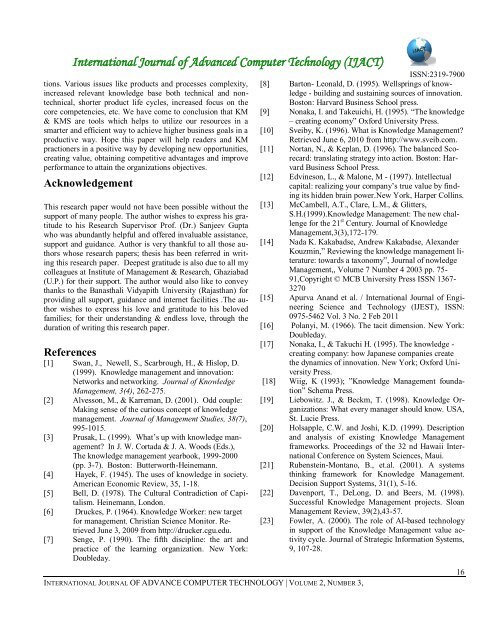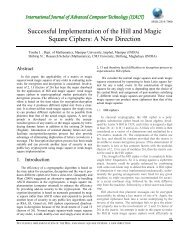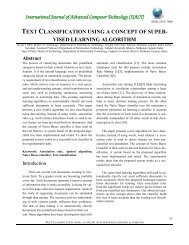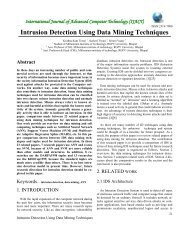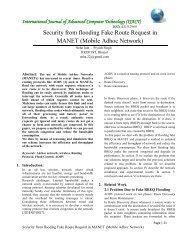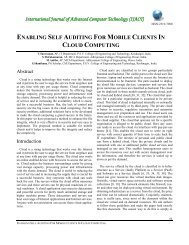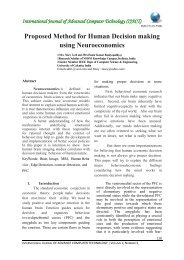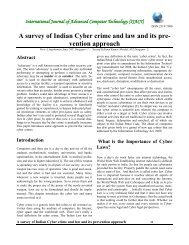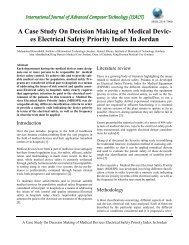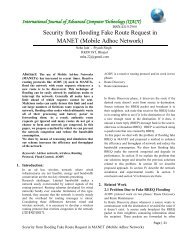A Literature Review - International Journal of Advanced Computer ...
A Literature Review - International Journal of Advanced Computer ...
A Literature Review - International Journal of Advanced Computer ...
Create successful ePaper yourself
Turn your PDF publications into a flip-book with our unique Google optimized e-Paper software.
<strong>International</strong> <strong>Journal</strong> <strong>of</strong> <strong>Advanced</strong> <strong>Computer</strong> Technology (IJACT)tions. Various issues like products and processes complexity,increased relevant knowledge base both technical and nontechnical,shorter product life cycles, increased focus on thecore competencies, etc. We have come to conclusion that KM& KMS are tools which helps to utilize our resources in asmarter and efficient way to achieve higher business goals in aproductive way. Hope this paper will help readers and KMpractioners in a positive way by developing new opportunities,creating value, obtaining competitive advantages and improveperformance to attain the organizations objectives.AcknowledgementThis research paper would not have been possible without thesupport <strong>of</strong> many people. The author wishes to express his gratitudeto his Research Supervisor Pr<strong>of</strong>. (Dr.) Sanjeev Guptawho was abundantly helpful and <strong>of</strong>fered invaluable assistance,support and guidance. Author is very thankful to all those authorswhose research papers; thesis has been referred in writingthis research paper. Deepest gratitude is also due to all mycolleagues at Institute <strong>of</strong> Management & Research, Ghaziabad(U.P.) for their support. The author would also like to conveythanks to the Banasthali Vidyapith University (Rajasthan) forproviding all support, guidance and internet facilities .The authorwishes to express his love and gratitude to his belovedfamilies; for their understanding & endless love, through theduration <strong>of</strong> writing this research paper.References[1] Swan, J., Newell, S., Scarbrough, H., & Hislop, D.(1999). Knowledge management and innovation:Networks and networking. <strong>Journal</strong> <strong>of</strong> KnowledgeManagement, 3(4), 262-275.[2] Alvesson, M., & Karreman, D. (2001). Odd couple:Making sense <strong>of</strong> the curious concept <strong>of</strong> knowledgemanagement. <strong>Journal</strong> <strong>of</strong> Management Studies, 38(7),995-1015.[3] Prusak, L. (1999). What‟s up with knowledge management?In J. W. Cortada & J. A. Woods (Eds.),The knowledge management yearbook, 1999-2000(pp. 3-7). Boston: Butterworth-Heinemann.[4] Hayek, F. (1945). The uses <strong>of</strong> knowledge in society.American Economic <strong>Review</strong>, 35, 1-18.[5] Bell, D. (1978). The Cultural Contradiction <strong>of</strong> Capitalism.Heinemann, London.[6] Druckes, P. (1964). Knowledge Worker: new targetfor management. Christian Science Monitor. RetrievedJune 3, 2009 from http://drucker.cgu.edu.[7] Senge, P. (1990). The fifth discipline: the art andpractice <strong>of</strong> the learning organization. New York:Doubleday.ISSN:2319-7900[8] Barton- Leonald, D. (1995). Wellsprings <strong>of</strong> knowledge- building and sustaining sources <strong>of</strong> innovation.Boston: Harvard Business School press.[9] Nonaka, I. and Takeuichi, H. (1995). “The knowledge– creating economy” Oxford University Press.[10] Sveiby, K. (1996). What is Knowledge Management?Retrieved June 6, 2010 from http://www.sveib.com.[11] Nortan, N., & Keplan, D. (1996). The balanced Scorecard:translating strategy into action. Boston: HarvardBusiness School Press.[12] Edvineson, L., & Malone, M - (1997). Intellectualcapital: realizing your company‟s true value by findingits hidden brain power.New York, Harper Collins.[13] McCambell, A.T., Clare, L.M., & Glitters,S.H.(1999).Knowledge Management: The new challengefor the 21 st Century. <strong>Journal</strong> <strong>of</strong> KnowledgeManagement,3(3),172-179.[14] Nada K. Kakabadse, Andrew Kakabadse, AlexanderKouzmin,” <strong>Review</strong>ing the knowledge management literature:towards a taxonomy”, <strong>Journal</strong> <strong>of</strong> nowledgeManagement,, Volume 7 Number 4 2003 pp. 75-91,Copyright © MCB University Press ISSN 1367-3270[15] Apurva Anand et al. / <strong>International</strong> <strong>Journal</strong> <strong>of</strong> EngineeringScience and Technology (IJEST), ISSN:0975-5462 Vol. 3 No. 2 Feb 2011[16] Polanyi, M. (1966). The tacit dimension. New York:Doubleday.[17] Nonaka, I., & Takuchi H. (1995). The knowledge -creating company: how Japanese companies createthe dynamics <strong>of</strong> innovation. New York; Oxford UniversityPress.[18] Wiig, K (1993); ”Knowledge Management foundation”Schema Press.[19] Liebowitz. J., & Beckm, T. (1998). Knowledge Organizations:What every manager should know. USA,St. Lucie Press.[20] Holsapple, C.W. and Joshi, K.D. (1999). Descriptionand analysis <strong>of</strong> existing Knowledge Managementframeworks. Proceedings <strong>of</strong> the 32 nd Hawaii <strong>International</strong>Conference on System Sciences, Maui.[21] Rubenstein-Montano, B., et.al. (2001). A systemsthinking framework for Knowledge Management.Decision Support Systems, 31(1), 5-16.[22] Davenport, T., DeLong, D. and Beers, M. (1998).Successful Knowledge Management projects. SloanManagement <strong>Review</strong>, 39(2),43-57.[23] Fowler, A. (2000). The role <strong>of</strong> AI-based technologyin support <strong>of</strong> the Knowledge Management value activitycycle. <strong>Journal</strong> <strong>of</strong> Strategic Information Systems,9, 107-28.INTERNATIONAL JOURNAL OF ADVANCE COMPUTER TECHNOLOGY | VOLUME 2, NUMBER 3,16


